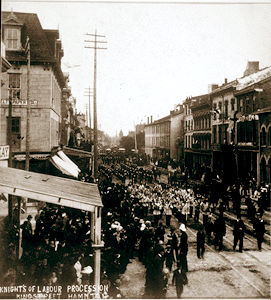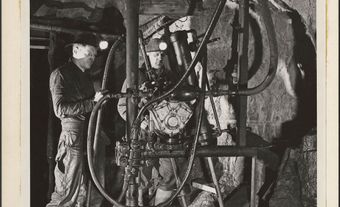
Labour relations refers to the relations between employers and employees. They are affected by a number of factors, including labour organizations, collective bargaining, labour market, government policy, the structure of the economy, labour law and technological change. Because labour relations are commonly associated with unions, it is significant that in Canada, until the 1970s, a majority of unions and union members belonged to American-based craft and industrial unions.
American employers are also influential - more than 4000 branch plants and subsidiaries of American corporations exist in Canada. In December 1987, Statistics Canada estimated that US-based unions acquired $56.5 million more from their members in Canada than they spent in Canada in 1985. During this century, labour relations in Canada and the US have been remarkably similar; a 1959 survey of 15 countries over more than 15 years described them as "a single system."
The outstanding feature of North American industrial relations, according to some observers, has been the unusually high incidence of strikes. Studies have also disclosed that the incidence of violence and illegality arising out of labour disputes has been much higher in the US and Canada than in other comparably industrialized countries - characteristics attributed to a few political and institutional factors that Canada, until the 1960s, shared with the US.
They included the relatively recent development of large-scale "mass unionization," a considerable residue of tension and mutual hostility arising from the widespread, protracted and frequently violent opposition of employers to unions; intense organizational and leadership rivalries among unions; the highly decentralized structure of labour organization and collective bargaining in most industries; and the absence of a strong or dominant labour party capable of gaining power at the national level.
Despite these broad similarities, however, labour relations in Canada have differed from those in the US in some important respects, which appear to have widened in recent years. For example, until the late 1950s the incidence of strikes in Canada was well below that of the US. Canada was less industrialized, with a smaller proportion of unionized workers. It underwent rapid industrialization and union growth during and after WWII and by the mid-1950s had reached virtual parity with the US in percentage of nonagricultural workers unionized. There was another dramatic upsurge in the later 1960s and the 1970s with the growth of public-sector unions. By 1987, 37.6% of nonagricultural workers in Canada were unionized, as compared to less than 20% in the US.
The relative strength of organized labour in Canada was also affected by cultural and ethnic divisions among workers, particularly the formidable gap between Francophones and Anglophones, which was exemplified by the formation of the separate francophone Confederation of National Trade Unions in Québec. Pronounced geographic and political divisions also precluded effective unionization and often set the interests of the workers in one region against those in another. For example, the interests of packing-house workers in the food-processing industry in eastern Canada have often conflicted with those of their western counterparts, particularly regarding transportation, international trade and government subsidies.
Politically, the labour movement had been divided since the turn of the century, when the Trades and Labour Congress, backed by the American Federation of Labor, evicted the militant Knights of Labor. Conflicts over opposing ideologies, programs and organizational objectives became less intense with the formation of the Canadian Labour Congress in 1956. Since then numerous unions have broken away from traditional American-controlled organizations in a drive for national autonomy. Some are in the CLC and some in the Confederation of Canadian Unions. Government intervention is another factor increasingly influencing labour relations.
Since W.L. Mackenzie King, as federal deputy minister, introduced the Industrial Disputes Investigation Act of 1907 to curb western Canada's militant coal-mine workers, governments in Canada have acted to maintain "law and order" and to protect employers' property and latitude of action rather than to protect the rights of employees to organize and bargain collectively. This tendency is evident in a history of expeditious resort to compulsory intervention, such as back-to-work legislation and binding arbitration, to settle disputes.
As far as employers are concerned, the Canadian situation differs from the American in that employers in most major industries in Canada have been relatively larger and more concentrated in their respective labour and product markets, and in earlier decades enjoyed relatively stronger bargaining power vis-à-vis organized labour. Where they have operated as subsidiaries or "branch plants," their strength has increased because their freedom to invest selectively and to relocate physically have provided them with an advantage in dealing with unions.
Labour relations changed dramatically during and after WWII, and Canadian and American positions were, in some respects, reversed. Union organization and membership grew more rapidly in Canada, and for the past several years union members have comprised a considerably larger percentage of the labour force. Since the 1950s the incidence of industrial conflict has also risen far more rapidly in Canada, and has remained at a considerably higher level for more than 20 years. Rapidly growing but highly erratic and irregular waves of industrial disputes developed in Canada from the mid-1960s to the mid-1980s, reaching record peaks in the numbers of strikes, workers involved and person-days lost in 1965, 1966, 1968, 1972, 1974, 1975, 1976 (the all-time high), 1980 and 1981.
During this period Canada shared with Italy the rather dubious distinction of having the world's highest annual average time loss per 1000 workers, with the US a distant third. Illegality and violence arising from labour disputes also increased in Canada during this period, particularly in Ontario and Québec, in a pattern reminiscent of the 1930s and earlier. As a result, and in response as well to the emergence of powerful public-sector unions, governments in Canada severely restricted organized labour. Strikes were banned in essential services, and in 1975 the federal government imposed a mandatory incomes policy administered by an anti-inflation board. "Six and five" legislation followed in the early 1980s, and various provincial governments imposed wage-guideline policies.
Labour relations have also been affected by the structure of the Canadian economy. During the 1960s and 1970s Canada's labour force grew more rapidly than that of any other industrial country and was accompanied by and dependent upon an unusually high rate of capital investment, particularly by American corporations. Postwar economic expansion, however, produced an economy heavily reliant upon primary-resource extraction and export, susceptible to "boom-and-bust" cycles.
Canadian governments, owing partly to the inability of a highly decentralized federal system of government to do so and partly to tradition, have not generally introduced measures to promote long-term stability or planning in the economy. Instability, inflation and unemployment have all generated corresponding instability in labour relations. The concentration of strikes in cyclically sensitive industries seems to indicate a close relationship between economic instability and industrial conflict.
Over the past 2 decades, only 6 industries, employing less than 15% of the labour force, accounted for more than 50% of all person-days lost and for more than 66% of the unusually large and protracted strikes. In order of percentage of time loss from strikes, they were construction, mining and smelting (particularly nickel), and (in manufacturing) transportation equipment (mainly automobiles), primary metals (mainly iron and steel) and wood products (mainly lumber and pulp and paper).
A by-product of Canada's rapid but unstable pattern of economic growth and one particularly provocative of industrial conflict has been the problem of wage disparities. During periods of rapid expansion, greater disparities have tended to develop within the general wage structure of Canada than within that of other industrial countries, primarily because of widely unequal rates of growth and profitability among different industries and regions and because of wide differences in bargaining power among unions.
In Canada's very decentralized labour movement, collective bargaining is highly localized and competitive. Three-quarters or more of all collective agreements are negotiated with individual employers, and multi-employer bargaining is usually local or district wide. The resulting differences in wages and fringe benefits have made it difficult for unions to achieve their general goal of parity among workers and have tended to provoke widespread conflict.
The problem of unequal growth during the 1960s and early 1970s particularly affected the public sector, partly because of growing intervention of government at all levels in disputes and strike-settlement procedures in other industries under the aegis of postwar labour legislation. The (implied) responsibility of governments for the gains in wages and benefits in the private sector and the wage lag in various public and publicly controlled sectors has resulted in the formation of militant unions, the enactment of new legislation providing for union certification and collective bargaining, and numerous large and protracted strikes among public-service workers.
The onset of a severe recession and serious unemployment in the 1980s greatly weakened the bargaining power of unions. On the other hand, new demands and policies by various public and private employers were viewed as serious threats to job and union security and, in the mid-to-late 1980s, provoked numerous incidents of picket line violence, injuries and arrests in labour disputes.
An even more serious recession developed in Canada during the early 1990s. During the ensuing recovery there has been a combination of stronger competition to Canadian industry on a global scale, growing labour displacement from technological change or "computerization" and widespread "downsizing" by federal and provincial governments, as well as by major employers in the private sector. These trends have kept the unemployment rate in Canada at double digit levels and greatly weakened the trade union movement generally in this country. The level of strike action has been far below previous decades. Indeed, unions in both the public and private sector have been forced to make substantial concessions in wages, hours and job security provisions.

 Share on Facebook
Share on Facebook Share on X
Share on X Share by Email
Share by Email Share on Google Classroom
Share on Google Classroom


